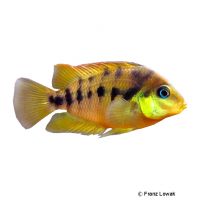Yellow Convict Cichlid (Cryptoheros nanoluteus)
| Yellow Convict Cichlid Cryptoheros nanoluteus | |
|---|---|
| Name | Yellow Convict Cichlid |
| Name Lat. | Cryptoheros nanoluteus |
| Synonym | Archocentrus nanoluteus |
| Family | Cichlids |
| Family lat. | Cichlidae |
| Order | Cichlids |
| Order lat. | Cichliformes |
| Origin | Central America |
| Habitat | Streams, rivers |
| Diet | Omnivore |
| pH | 6.0-7.5 |
| Behavior | Semi-aggressive |
| Keeping | Pair |
| Care Level | Moderate |
| Reproduction | Cave spawner |
| Breeding | Moderately difficult |
| Life Span | 5-8 years |
| Protection | No |
| Metric Units | |
| Size | 6-9 cm |
| Temperature | 23-26 °C |
| Hardness | 10-25 °dH |
| Aquarium | 100 cm / 200 l |
| US Units | |
| Size | 2.4"-3.5" |
| Temperature | 73-79 °F |
| Hardness | 178-445 ppm |
| Aquarium | 50 gal |
Distribution and habitat
The Yellow Panama Cichlids are found exclusively (endemically) in the inlet of the Rio Guarumo in northwestern Panama. There they live in clear streams and small rivers with weak to medium currents, where they find numerous shelter and hiding places, such as stones, roots and branches, as well as a sandy bottom covered with fallen leaves.
Maintenance
The aquarium should have dense planting that provides both shelter and swimming space, with plenty of roots and rocks for hiding. A dark, sandy substrate covered with some foliage (sea almond tree, oak), subdued light (floating plants) and oxygen-rich, medium to hard water with a weak current is ideal.
No ammonia, ammonium and nitrite should be detectable, the nitrate value should not exceed 100 mg/l. To ensure the water quality and oxygen content, a filter and heater adapted to the aquarium size is required, as well as lighting for the species-appropriate day-night rhythm of the animals.
Diet
The food supply consists of a high quality sinking dry food for cichlids (pellets, granules) supplemented with live or frozen food, such as artemia, mysis, tubifex and red mosquito larvae or a commercial frozen special food mix for cichlids. In addition, they also need vegetable food, such as crushed peas, spinach, algae leaves or dry food with high vegetable content (spirulina)
Only feed as much as will be eaten immediately (in 10 minutes or less). Regular and varied feeding promotes health and increases resistance.
Behaviour and compatibility
These calm and relatively peaceful fish should be kept in pairs. Due to their intraspecies aggressiveness, keeping multiple pairs is only recommended in much larger tanks. They can be socialized with larger, peaceful fish such as barbs and catfish. Fish that are too small are considered prey. Basically, only compatible fish species with similar demands on water condition and water temperature may be socialized.
Sex dimorphism
Males are more colorful, especially at mating time, and have extended dorsal and anal fins. Females have a characteristic dark spot on the dorsal fin.
Reproduction and breeding
They prefer to spawn in a cave or other hiding place. The female performs brood care, while the male defends the territory (parental family). After 3-4 days, the fry hatch and are then housed and guarded in a bottom pit prepared outside the cave until they swim free after 4-7 days. The school of fry continues to be guarded by the parent fish for several weeks before brood care ends.
Fry must be fed several times a day with special rearing food (e.g. Artemia nauplii). in community tanks breeding is hardly possible, because the fry are easy prey.
Important
They should not be socialized with other Cryptoheros or Archocentrus as they may interbreed
They hardly burrow and plants are not damaged.
The well-being of the fish should be checked regularly. Temperature should be checked daily, pH, hardness and nitrate levels at least fortnightly. A regular partial water change is recommended, even if the pollutant load has not yet reached the upper limit. Sudden changes in water quality should be avoided. Newly introduced fish must be accustomed slowly to the water in the aquarium.
Further literature can be found in your pet store.
References
Text: petdata; Image: Franz Lowak
Source: BMELV (1998): Tierschutzgutachten - Haltung von Zierfischen (Süßwasser); BAENSCH & RIEHL (2004): Aquarien Atlas Bd. 4, Mergus Verlag; ENGELMANN (2005): Zootierhaltung - Tiere in menschlicher Obhut: Fische, Verlag Harri Deutsch
- Gemäß § 21 Abs. 5 Tierschutzgesetz idgF
